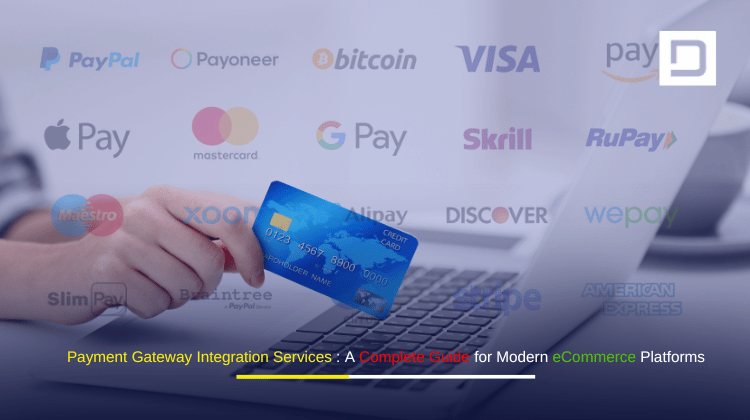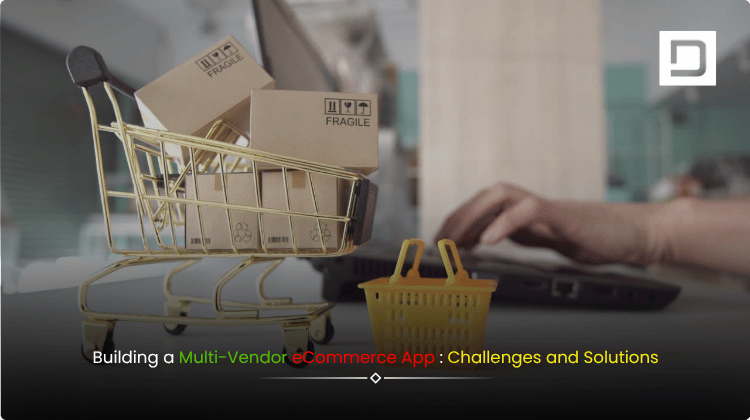Building a Multi-Vendor eCommerce App: Challenges and Solutions
In the fast-evolving world of digital commerce, building a multi-vendor eCommerce app stands as one of the most impactful business decisions for companies aiming to dominate the online retail space. The concept of a multi-vendor eCommerce app has become a cornerstone for platforms like Amazon, Flipkart, Etsy, and Alibaba, which empower multiple vendors to sell products within a unified marketplace. As consumer behaviors shift towards convenience, personalization, and variety, the demand for robust, scalable, and intelligent multi-vendor marketplaces is surging.
But building a successful multi-vendor eCommerce app is no small feat. It involves overcoming a unique set of challenges related to architecture, scalability, vendor onboarding, payment integration, commission management, logistics, user experience, security, and ongoing maintenance. This comprehensive guide explores every major challenge in building a multi-vendor eCommerce app and offers actionable solutions—drawing on Depex Technologies’ extensive experience in custom eCommerce app development.
In today’s hyper-connected world, building a multi-vendor eCommerce app offers immense value for businesses seeking to tap into diverse product ranges, serve a broader audience, and generate revenue from multiple streams. The keyword “Building a Multi-Vendor eCommerce App” is at the core of this digital revolution, as it involves uniting buyers and sellers on a single, convenient, and scalable platform.
Whether you are a retail startup, a brick-and-mortar business aiming to expand online, or an established enterprise looking to modernize, understanding the journey of multi-vendor eCommerce app development is critical to long-term success. This blog delves into every aspect of the process—from initial concept and feature planning to addressing the biggest challenges and implementing robust solutions.
Understanding the Multi-Vendor eCommerce Model
A multi-vendor eCommerce app is a digital platform that connects multiple independent vendors or sellers with customers, all within a single ecosystem. Unlike a single-vendor store, where only one business offers products, a multi-vendor marketplace allows hundreds or thousands of sellers to list, manage, and sell their products to a shared customer base.
How It Works
- Vendors register on the platform and manage their own storefronts.
- Admins oversee marketplace operations, set commission rates, and manage payments.
- Customers browse products from multiple sellers, add items to a unified cart, and complete purchases in a single checkout.
- Order processing and logistics are coordinated between vendors and the platform.
This model offers tremendous benefits—expanded product variety, competitive pricing, faster growth, and multiple revenue streams. However, it introduces complexities that must be tackled head-on during development.
Market Trends and Opportunities
The global eCommerce landscape is evolving rapidly, and the demand for multi-vendor marketplaces is at an all-time high. According to Statista, the worldwide eCommerce market is projected to surpass $8 trillion by 2027, with multi-vendor platforms contributing a significant share. Marketplaces like Amazon, eBay, Walmart, and niche platforms such as Etsy and ThemeForest are clear evidence of this shift.
Key trends driving multi-vendor eCommerce app adoption:
- Growth of mobile commerce: Over 70% of eCommerce sales now occur via mobile devices, making mobile-first design a necessity.
- Expansion of niche and hyperlocal marketplaces: Specialized platforms cater to unique product categories or local markets.
- Rise of social commerce: Integration with social platforms boosts vendor visibility and customer engagement.
- Focus on seamless logistics and faster deliveries: Marketplaces compete by offering same-day or next-day delivery options.
Businesses that invest in building a multi-vendor eCommerce app position themselves for exponential growth, brand loyalty, and competitive differentiation.
Key Features of a Multi-Vendor eCommerce App
Building a successful multi-vendor eCommerce app requires a well-thought-out feature set for three primary user roles: Admin, Vendor, and Customer. Below, we explain each critical feature in detail.
1 Admin Features
- Dashboard: A comprehensive control panel for managing the entire platform—vendor approvals, order status, commission setup, dispute resolution, and analytics.
- Commission Management: Set global or vendor-specific commission rates, automate calculations, and manage payouts.
- Product Moderation: Approve or reject product listings to maintain quality and compliance.
- Order Tracking: Monitor order statuses, handle disputes, and ensure smooth operations.
- Analytics & Reports: Real-time insights on sales, revenue, traffic, vendor performance, and customer trends.
2 Vendor Features
- Vendor Dashboard: Manage products, inventory, orders, earnings, and account information.
- Product Management: Add, edit, and organize products, set prices, manage stock, and upload images.
- Order Management: Process orders, update shipping status, print invoices, and handle returns.
- Sales Analytics: Track performance metrics, understand customer preferences, and optimize offerings.
- Vendor Profile Customization: Build brand identity with custom logos, banners, and store descriptions.
3 Customer Features
- User Registration & Profiles: Seamless sign-up, login, and profile management (including social logins).
- Product Search & Filters: Advanced search, filters, and category navigation for a personalized shopping experience.
- Unified Cart & Checkout: Add products from multiple vendors to a single cart, simplified checkout with multiple payment options.
- Order Tracking: Real-time updates on order status, shipping, and delivery.
- Ratings & Reviews: Build trust with transparent feedback for products and vendors.
- Wishlist & Recommendations: Save favorite items and receive personalized product suggestions.
Top Challenges in Building a Multi-Vendor eCommerce App
While the potential rewards are enormous, the journey of building a multi-vendor eCommerce app is filled with unique challenges that must be addressed at every stage of development. Let’s explore these critical pain points and why they matter.
1 Architectural Complexity and Scalability
Multi-vendor apps require a robust, modular architecture to accommodate multiple users, vendors, and ever-increasing transactions. Without careful planning, performance bottlenecks, data inconsistency, and security flaws can arise as the platform scales.
Key concerns:
- Handling thousands of simultaneous users.
- Real-time data synchronization (orders, inventory, pricing).
- Modular structure for easy feature expansion.
2 Vendor Onboarding and Management
Attracting and retaining quality vendors is essential. Complex registration processes, lack of transparency, or cumbersome verification can drive vendors away. The platform must streamline onboarding while ensuring compliance and quality standards.
Key concerns:
- Easy, secure vendor registration and verification.
- Comprehensive KYC (Know Your Customer) and documentation.
- Ongoing vendor support and communication.
3 Product Catalog Management
Managing a diverse catalog across hundreds of vendors introduces issues of data consistency, duplicate listings, quality control, and real-time inventory management. The platform must empower vendors while maintaining overall marketplace quality.
Key concerns:
- Standardized product data and categorization.
- Duplicate and counterfeit product prevention.
- Automated quality checks and moderation.
4 Payment Gateway Integration and Split Payments
Processing payments from customers and automatically splitting funds between vendors and the platform is complex. Supporting multiple payment options, ensuring timely vendor payouts, and complying with financial regulations adds further challenges.

Key concerns:
- Secure integration with global/local payment gateways.
- Automated split payments (multi-party payment).
- Handling refunds, cancellations, and disputes.
5 Commission Management
Multi-vendor marketplaces generate revenue through commissions. Manual tracking is error-prone and unsustainable. Automating commission calculations, deductions, and payouts—while providing transparency—can be complex.
Key concerns:
- Configurable commission structures (global, per-category, per-vendor).
- Automated calculation and reporting.
- Transparent vendor earnings dashboard.
6 Order Fulfillment and Logistics
Coordinating order fulfillment between multiple vendors and logistics providers is a massive undertaking. The platform must ensure timely delivery, efficient returns, and clear tracking for customers.
Key concerns:
- Real-time order status updates for all parties.
- Integration with logistics partners and delivery APIs.
- Automated notifications and communication.
7 Customer Experience & Personalization
With so many vendors and products, it’s easy for the user experience to become cluttered or overwhelming. Personalization, intuitive navigation, and responsive design are crucial to maximize user satisfaction and retention.
Key concerns:
- Personalized product recommendations and promotions.
- Seamless mobile and web experience.
- Quick, reliable customer support.
8 Data Security and Compliance
Multi-vendor platforms handle sensitive customer and vendor data, including payments, addresses, and identification documents. Security breaches can destroy trust and invite legal penalties.
Key concerns:
- Secure user authentication and data encryption.
- Compliance with GDPR, CCPA, and other data protection laws.
- Proactive threat monitoring and prevention.
9 Ongoing Support and Maintenance
An eCommerce marketplace is never truly “done.” Continuous monitoring, bug fixes, security updates, feature enhancements, and scaling are ongoing responsibilities that require expertise and dedication.
Key concerns:
- Timely technical support and issue resolution.
- Regular platform updates and improvements.
- Scaling infrastructure as traffic grows.
Best Solutions for Overcoming Challenges
At Depex Technologies, we believe that every challenge is an opportunity to build a stronger, smarter marketplace. Here’s how we tackle the most common obstacles in building a multi-vendor eCommerce app:
1 Choosing the Right Tech Stack
A modular, microservices-based architecture allows each part of the app to scale independently, reducing downtime and bottlenecks. We leverage industry-leading frameworks like React, Node.js, Laravel, Flutter, or React Native for cross-platform compatibility, robust APIs, and seamless integrations.
- Cloud infrastructure (AWS, Azure, Google Cloud): For high availability and scalability.
- NoSQL/SQL databases: For fast, reliable data storage and access.
- API-first design: For easier integration with third-party tools and services.
2 Streamlining Vendor Onboarding
We automate vendor registration with digital KYC verification, document upload, and smart onboarding wizards. Multi-step onboarding ensures that vendors submit all necessary information, while the admin has tools to approve, reject, or request more details quickly.
- Vendor portal: Central hub for onboarding, support, and training resources.
- Automated compliance checks: Prevent fraud and ensure marketplace standards.
3 Robust Catalog & Inventory Management
Using intelligent product data models and bulk upload tools, we enable vendors to manage catalogs efficiently. Automated moderation detects duplicates, mismatches, and quality issues. Centralized inventory management keeps stock levels in sync in real time, reducing overselling or stockouts.
- Advanced search and filters: For both customers and admins.
- AI-based product categorization: Increases discoverability and user satisfaction.
4 Scalable Payment Systems
We integrate with trusted payment gateways like Stripe, PayPal, Razorpay, and Adyen, enabling multi-currency support and secure transactions. Custom payment logic ensures automated split payments, transparent commission deductions, and timely vendor payouts.
- Automated refunds and chargebacks: Streamlined process to resolve disputes.
- Escrow systems: Secure customer funds until orders are fulfilled.
5 Automating Commission and Payouts
A dynamic commission engine allows admins to set and update commission rates by vendor, category, or product type. Real-time analytics and reporting tools provide transparency for both vendors and admins, reducing payment disputes.
- Detailed earnings dashboard: For vendor trust and clarity.
- Automated monthly/weekly payouts: Saves admin time and prevents errors.
6 Efficient Logistics Integration
We connect with leading logistics APIs for shipping, order tracking, and returns. Automated notifications keep customers informed at every stage. Vendor-specific shipping settings ensure accurate delivery cost calculation.
- Integrated tracking: Real-time updates on orders and deliveries.
- Return and refund management: Simplifies the post-purchase experience.
7 AI-Powered Personalization
We harness machine learning and recommendation engines to personalize product suggestions, offers, and email campaigns. Personalized shopping experiences increase user engagement, average order value, and customer retention.
- Smart search: Predictive typing and contextual results.
- Behavioral analytics: Identify buying patterns and target segments.
8 Security-First Development Approach
We implement multi-factor authentication, SSL encryption, token-based authentication, and regular security audits to protect sensitive data. Compliance modules ensure adherence to privacy laws across global markets.
- Continuous vulnerability scanning: To address new threats proactively.
- GDPR and CCPA compliance: User data rights, deletion, and access protocols.
9 Dedicated Support and Continuous Improvement
We offer 24/7 technical support, regular maintenance, and agile updates to keep the marketplace performing at its best. Proactive monitoring identifies and resolves issues before they affect users.
- Performance monitoring: For uptime and speed optimization.
- Customer support integration: Live chat, ticketing, and self-service help.
The Depex Technologies Approach
At Depex Technologies, our end-to-end expertise in building multi-vendor eCommerce apps sets us apart. We go beyond code to deliver business value at every step:
- Consultation: Deep dive into your business goals, target audience, and unique needs.
- Strategy: Detailed project roadmap, technology recommendations, and market research.
- UI/UX Design: Wireframes, prototypes, and user testing for seamless user journeys.
- Development: Agile, modular, and scalable coding practices.
- Quality Assurance: Rigorous manual and automated testing.
- Launch: Seamless go-live, migration support, and training.
- Growth Partnership: Ongoing support, analytics, and optimization.
Our proven methodology ensures that your multi-vendor marketplace is future-proof, competitive, and ready for exponential growth.
Case Studies & Success Stories
Marketplace for Local Artisans
Depex Technologies partnered with a European startup to launch a multi-vendor eCommerce app for local artisans. Vendors could sign up, create profiles, and list handmade products. The app integrated real-time chat, automated payments, and delivery partner APIs. Within 12 months, the platform scaled to 5,000+ active vendors and 50,000 customers.
Key Outcomes:
- 70% faster vendor onboarding
- 30% increase in average order value
- Near 99.9% uptime post-launch
B2B Multi-Vendor Wholesale Platform
A global B2B wholesaler approached Depex Technologies to digitize their supplier network. We built a custom multi-vendor web and mobile app with advanced search, RFQ (Request for Quotation) workflows, and AI-powered pricing suggestions. The result was a 45% reduction in manual processing and a 60% increase in repeat orders.
Cost Factors & Timeline for Development
How much does it cost to build a multi-vendor eCommerce app? The answer depends on several variables:
- Features and complexity: More advanced features (AI recommendations, custom dashboards, integrations) increase cost.
- Number of user roles: Admin, vendor, sub-admin, customer, delivery partner.
- Platform: iOS, Android, web, or cross-platform.
- Design: Custom UI/UX or template-based.
- Integrations: Payment gateways, logistics, CRM, third-party APIs.
- Security and compliance: Costs may rise for advanced security and legal compliance.

At Depex Technologies, we provide flexible engagement models—fixed price, dedicated team, or hybrid approaches—to suit your needs and budget.
Why Depex Technologies Is Your Ideal Multi-Vendor eCommerce Partner
Choosing the right technology partner is crucial to success in the competitive world of online marketplaces. Here’s why Depex Technologies should be your first choice for building a multi-vendor eCommerce app:

- Extensive domain expertise: Years of experience building eCommerce solutions across industries and geographies.
- Agile and transparent process: Regular updates, demos, and collaborative decision-making.
- Cutting-edge technology: Modern stacks for performance, scalability, and future-readiness.
- Security-first mindset: Proactive approach to data protection and compliance.
- Focus on ROI: Every feature is aligned with your business goals and user experience.
- Ongoing support: From launch to growth, we’re with you every step of the way.
We don’t just build apps—we build long-term partnerships for digital transformation and marketplace dominance.
Conclusion
Building a multi-vendor eCommerce app is a bold, strategic move for any business ready to capture the future of digital commerce. While the journey is full of challenges—architectural complexity, vendor management, payment integration, logistics, security, and more—choosing the right solutions and an experienced development partner can turn these obstacles into competitive advantages.
At Depex Technologies, we combine technical excellence with deep business understanding to deliver robust, scalable, and user-friendly multi-vendor eCommerce platforms. Our commitment is not just to launch your marketplace but to help it grow, adapt, and thrive in a rapidly changing digital landscape.
Ready to launch or upgrade your multi-vendor Contact us Depex Technologies Now.






